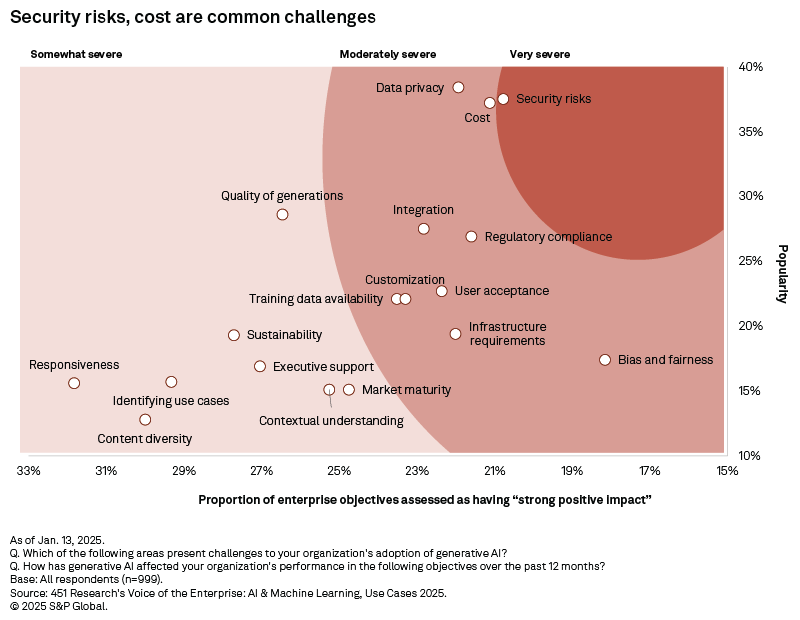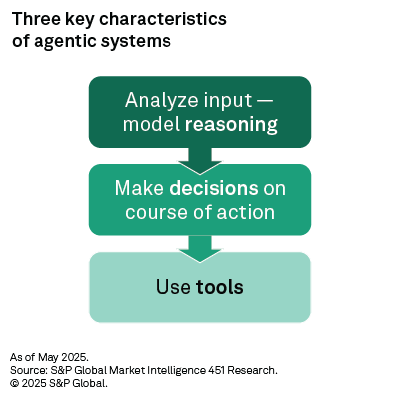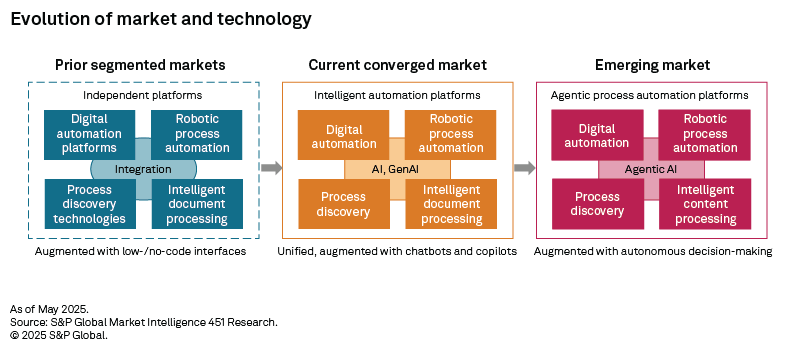Featured Topics
Featured Products
Events
S&P Global Offerings
Featured Topics
Featured Products
Events
S&P Global Offerings
Featured Topics
Featured Products
Events
S&P Global Offerings
Featured Topics
Featured Products
Events
Financial and Market intelligence
Fundamental & Alternative Datasets
Government & Defense
Banking & Capital Markets
Economy & Finance
Energy Transition & Sustainability
Technology & Innovation
Podcasts & Newsletters
Financial and Market intelligence
Fundamental & Alternative Datasets
Government & Defense
Banking & Capital Markets
Economy & Finance
Energy Transition & Sustainability
Technology & Innovation
Podcasts & Newsletters
Research — JUNE 12, 2025
The rapid transformation of enterprise workflows by AI, especially in code generation, is accompanied by significant challenges in implementing generative AI projects, underscoring the need for enhanced security and operational efficiency. This report rounds up the latest developments curated for IT decision-makers.

AI is rapidly reshaping enterprise workflows, unlocking powerful new capabilities but also introducing significant implementation challenges. A key hurdle is the high number of generative AI projects that stall before reaching production. This is largely driven by the accelerated adoption of AI, fueled by pressure to deliver quick results, combined with the high failure rates typical of early-stage disruptive technologies. One area where GenAI is shining is the code-generation space, with tools designed to boost productivity and simplify development. Innovations in natural language interfaces are making it possible for even non-developers to build and use AI, expanding access across the enterprise.
At the same time, embedding AI into cybersecurity and IT operations is raising the stakes. Managing AI agents securely and maintaining operational oversight is becoming more complex. In response, forward-looking IT leaders are turning to AI-powered automation platforms that help centralize control, enhance collaboration and scale operations — enabling real-time decision-making and faster issue resolution. The path forward is clear: Success with AI means aligning its power with strong security and operational efficiency. IT leaders who master this balance will be at the forefront of the next wave of digital transformation.

AI in focus: Code generators and related security concerns
The number of AI projects abandoned before production remains high — the median is 46%, according to S&P Global Market Intelligence 451 Research's Voice of the Enterprise: AI & Machine Learning, Use Cases 2025 survey. Many AI projects are abandoned preproduction because they are not coded and, therefore, fail to address the nuances and complexity required by current data science and AI products. As such, the code-generation sector, which incorporates data science and AI platforms, is one of the fastest-growing markets that CTOs and CIOs must evaluate.
Our research shows that the code-generation sector is projected to grow at a compound annual growth rate of 53% from 2024 to 2029, surpassing other GenAI modalities. Revenue forecasts for 2025 have been revised upward for code generators, increasing from $2.6 million in the 2024 edition to $3.9 million. Code generators have benefited from the strong productivity and metrics-driven culture surrounding programming tasks in many organizations, making it easier to justify scaling up early pilots.
The rigorous quality assurance processes in software development have also helped address some of the hallucination issues associated with GenAI, aiding code generation products to gain early traction within the enterprise market. Additionally, interest in "vibe coding" — where non-developers use natural language to instruct AI to write code — has helped build a consumer audience for these products. Responding to this interest, numerous specialist code generator startups have emerged, with sector coverage expanding from 52 entities in June 2024 to 71 companies in 2025.
AI also remains a central topic for cybersecurity, as it is across most other aspects of technology, and that seems unlikely to diminish any time soon — quite the opposite, in fact. An explosion of AI agents introduces a potentially more complex environment for managing functionality, ultimately aiming for greater autonomy in comprehension and actions. This will likely have a significant impact on security, especially in devising ways to assure accountability and control for agentic functionality — and thus, a likely impact on the identities and privileges associated with agents. While specifications such as Agent2Agent and model context protocols are emerging, there is far more work to be done on the security front to help assure the already exploding adoption of GenAI.

M&A and market moves: Salesforce to acquire Informatica for roughly $8 billion in equity value
Salesforce Inc. has been on a path to deepen its data capabilities for several years since launching Salesforce Data Cloud, including the acquisitions of Mulesoft and Tableau. Informatica Inc. provides Salesforce with master data management services, including areas that Salesforce needs, such as data catalog, improved data integration, stronger data governance and metadata management. As enterprises grapple with shifting to agentic AI and AI-powered agents — designed to analyze data, make decisions and take actions without human intervention — Salesforce is augmenting its customer experience depth with data-driven capabilities to automate more complex processes. Our research in the 2025 Trends in Customer Experience & Commerce report predicted that enterprises will require improved focus on data strategies for agentic AI to drive digital maturity advancements.
Key industry conferences: Security and cross-border payment in focus
RSAC is the largest cybersecurity industry event, attracting thousands of attendees, speakers and exhibitors. Once again, security for AI and AI for security were the topics discussed most at the event. There is abundant reason for CIOs, CTOs and security practitioners to be simultaneously hugely optimistic and markedly pessimistic. While AI promises to better handle overwhelming volumes of security data and processes, it also introduces entirely new categories of cyberrisk on multiple fronts. Yet AI was not the only high-profile topic at the RSAC Conference 2025. In our Voice of the Enterprise: Information Security, SecOps 2024 survey, respondents indicated they were unable to investigate 43% of security information and event management/security alerts in a typical day, down 11 percentage points from 2023 (54%) — the most significant change, and the first drop, since we first asked the question in 2020. Early gains from deploying GenAI-based assistants may also be contributing, aiding security analysts by reducing the analytical burden of performing alert analyses, determining likely root causes and recommending potential courses of action. In the future, agents will likely also be capable of automating routine actions autonomously or with a human in the loop. The dawn of the agentic security operations center is clearly upon us.

The Money20/20 Asia conference arrived at a pivotal moment for global payments. With tariffs and trade tensions prompting companies to reexamine supply chains, Asia faces growing demand for faster, cheaper and more reliable cross-border payment infrastructure. Currency volatility and regulatory fragmentation have heightened the urgency for innovation in how money moves across borders, setting the event's tone. Stablecoins, once met with hesitation, also drew increased attention. CTOs are interested in stablecoins because they represent a shift in how financial technology is built, potentially impacting infrastructure, scalability and security. They are crucial for companies looking to integrate digital assets and leverage blockchain technology, particularly for cross-border payments and decentralized finance (DeFi) applications. The growing buzz around stablecoins comes at a time of rising market volatility and shifting global trade flows, driven partly by US tariffs and a reordering of supply chains. For global businesses navigating these disruptions, stablecoins offer a compelling alternative to traditional rails by speeding up settlement, reducing currency risk and providing predictability in complex, cross-border payment corridors.
"Writing checks [to pay bills] is becoming obsolete. Occasionally, I may write or have a check written … but for the most part, most of our [payments] are all done electronically, EFT, wire transfers, things like that … I think my vendors are looking more and more just like I do. It's easier for us to do it."
Source: Financial services respondent, 451 Research's Voice of the Enterprise in-depth interview, January 2025.
Emerging tech: The intersection of IT automation and AI agents
IT departments face growing complexity in managing and integrating IT automation and operations tools. As organizations scale hybrid IT environments, adopt cloud-native technologies and explore AI-augmented systems, the challenge of tool sprawl becomes more pronounced. Disparate tools often must work together for everyday tasks, including application development, resource provisioning, configuration management and incident resolution, and integrating these systems can be complex and resource-intensive. Tool sprawl can drain IT productivity, forcing teams to spend time making tools work together rather than focusing on strategic initiatives. In response, organizations are turning to a new generation of AI-powered unified IT automation platforms to provide a framework for designing, executing and managing mission-critical IT processes. Automation is becoming central to enterprise AI strategies. For AI to deliver on its promise — analyzing data in real time, making decisions and potentially taking autonomous action — it must be integrated into IT workflows through automation. As a result, automation is now seen as critical to AI and IT operational success. Enterprises are investing in strategic automation platforms that reduce operational inefficiencies and prepare IT environments for scalable, AI-driven transformation.
A new class of unified IT automation platforms aims to alleviate the burdens of integrating diverse tools, leveraging AI to centralize control and facilitate collaboration across IT environments. Key capabilities such as IT service management and generative and agentic AI have emerged as priorities, underscoring the intertwined nature of automation and AI strategies. The benefits of such platforms include improved scalability, IT customer service and consistency in IT process execution.
Furthermore, AI is poised, when trusted, to play a critical role in enabling real-time decision-making and proactive issue resolution without human intervention. The emergence of such AI-powered unified IT automation platforms will likely play a vital role in helping IT tool interoperability that tames the challenges of IT tool sprawl to enhance the efficiency of IT organizations.

"[The ROI from GenAI] is one of three things: efficiency gain, automation through automation or productivity in terms of time saving or indirectly or directly contributing to cost saving of revenue."
Source: Manufacturing respondent, 451 Research's Voice of the Enterprise in-depth interview, February 2025.
10 companies to track
Silverstream AI Inc.: The company emerged from stealth with a $1.2 million pre-seed investment led by Gradient Ventures (a venture fund from Google) and supported by Vento Ventures. The company launched an open dataset of agentic web interactions designed to train agents to operate more effectively with web applications.
Bedrock Labs Inc.: Founded in 2022, the company's data security SaaS offering features several components to enable security via data discovery and classification. At the base layer, its Metadata Lake aggregates more than 50 facets about any single data item, spanning fingerprints, entitlements, classifications and activities. A confluence of technologies has presented opportunities to protect large amounts of personally identifiable information.
Zerve AI Ltd.: Launched in 2021, the company aims to enable coders to create and roll out data offerings by removing the complexity of orchestration, scaling and deployment. One patent involves decoupling storage and computing to allow the spinning up and down of virtual machines as required by the jobs being processed. Its distributed computing environment is also designed to be easy to execute, as it involves writing one line of code.
ConfigHub Inc.: The company was formed to address the complexity of managing cloud-native application configurations, which are now an amalgamation of parts, pieces and interdependencies. The company's goal is to transform and simplify how application operations are managed in production, which is compounded by the complexities of Kubernetes operations, and going forward, by AI.
Databook Labs Inc.: The company offers an AI-powered platform that helps enterprise sales teams build strategic customer relationships. It delivers real-time account insights, automates planning and prep and generates personalized materials to support high-value deals. By analyzing market and financial data, Databook enables sellers to prioritize opportunities, tailor messaging to buyer needs and craft executive-ready narratives that accelerate deal size and growth.
Flip GmbH: The employee experience mobile platform combines communication tools with intranet-like feeds, news and native integrations. It supports pre-boarding, onboarding, shift swap and scheduling, pay slip access and time-off requests, emergency notifications, open role announcements, and referrals. The platform's homepage can be customized as a feed or grid view, allowing users to filter content by channels, save posts and engage in chats, tasks and calendar management.
Juspay Technologies Private Ltd.: The payment infrastructure provider is headquartered in India. The vendor's open-source approach to payment orchestration targets a latent opportunity in the market — large enterprises often lack the resources to optimize their multiprocessor stacks fully. With its new product, Hyperswitch, enterprise payment teams can achieve greater control and customization of their orchestration strategy.
Diliko: With security at the forefront of its approach, the company offers data integration and associated data management functionality — supported by agentic AI — that reduces complexity, increases ease of use and enhances security outcomes, helping data engineers and other associated personnel.
Buckzy Payments Inc.: It has carved out a strong niche in the business-to-business cross-border payments space. Most instant cross-border payment offerings today are designed for person-to-person use cases such as remittances, not high-value business-to-business flows, which demand IT security with liquidity control and compliance readiness for business users. The Toronto-based fintech has a flexible infrastructure for real-time B2B payments, combining local rails, intelligent routing and embedded banking.
Moderne Inc.: The company is an automated code analysis and refactoring specialist focusing on better understanding and effectively modernizing massive enterprise code bases, leveraging automation and AI. Moderne's platform collects and references everything a code compiler knows to support modernization for enterprise customers. The vendor's latest enhancements leverage agentic AI to fuel large-scale code analysis, security and modernization.
What to watch
Several key areas warrant close attention as the AI landscape continues to evolve. One critical aspect is the development of advanced security measures to address the complexities introduced by AI agents, ensuring accountability and control over their functionalities. Organizations should also monitor the progress of AI-powered automation platforms, which promise to enhance IT operations by reducing tool sprawl and improving interoperability. These developments will play a crucial role in shaping the future of AI and enterprise technology, offering new opportunities and challenges for businesses worldwide. S&P Global Market Intelligence 451 Research provides essential insight into the pace and extent of digital transformation across the global technology landscape. 451 Research offers differentiated insight and data on adoption, innovation and disruption across the technology markets, backed by a global team of industry experts. Keeping an eye on these developments will be essential for organizations aiming to navigate the complexities of digital transformation successfully.
This article was published by S&P Global Market Intelligence and not by S&P Global Ratings, which is a separately managed division of S&P Global.
Economics of Networks is a regular feature from S&P Global Market Intelligence Kagan. Consumer Insights is a regular feature from S&P Global Market Intelligence Kagan
Location
Products & Offerings
Segment
